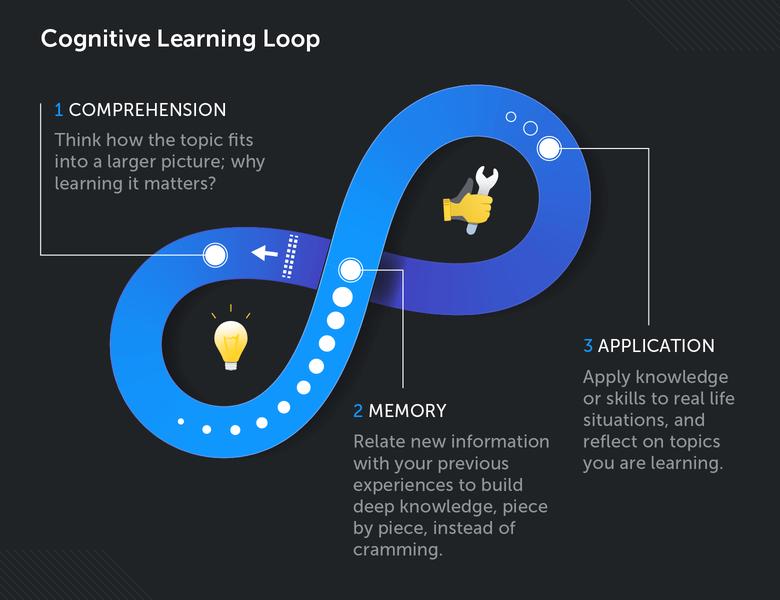TheoreticalIntroduction
Thecognitivelearningtheoristsbelievethatlearningliesinthechangeofinternalcognition,andlearningismorethanS-RconnectionAmuchmorecomplicatedprocess.Theypayattentiontoexplainingtheintermediateprocessoflearningbehavior,thatis,purpose,meaning,etc.,andbelievethattheseprocessesarethevariablefactorsthatcontrollearning.
Theoreticalviewpoint
Kehler’sepiphanytheory
ThecognitivetheoryoflearningoriginatedfromtheGestalttheoryoftheGermanGestaltschoolofpsychology.ThefoundersofGestaltPsychologyareGermanpsychologistsM.Wertheimer,K.KoffkaandKoehler.Basedontheresultsof18experimentsconductedonchimpanzeesover7years,Koehlerwrotethearticle"TheWisdomofOrangutans".HeappliedtheGestalttheoryandputforwardtheepiphanytheory.Mainpoints:First,learningisaboutorganizingandconstructingagestalt,ratherthanasimpleconnectionofstimulationandresponse.Second,learningisanepiphany,notachievedthroughtrialanderror.Theepiphanytheoryattachesimportancetotheorganizationalrolebetweenstimulusandresponse,andbelievesthatthisorganizationismanifestedasthesuddenreorganizationoftheoldorganizationalstructure(gestalt)intheperceptualexperienceortheinsightofthenewstructure.
Tolman’sCognitive-SkoposTheory
TolmanisdissatisfiedwiththeinterpretationoftheS-Rconnectiontheory.HebelievesthattheresultoflearningisnotadirectconnectionbetweenSandR,andadvocatesChangetheS-RformulatotheS-O-Rformula.Inthelatterformula,Orepresentstheinternalchangesoftheorganism.Tolman'slearningtheoryhastwomajorcharacteristics:First,alllearningisapurposefulactivity.Second,inordertoachievethepurposeoflearning,thelearningconditionsmustberecognized.Tolmanuses"symbols"torepresenttheorganism'scognitionoftheenvironment.Hebelievesthatintheprocessofachievingthegoal,learnerslearnthesymbolsthatcanachievethegoalandthemeaningsrepresentedbythesymbols,whichformacertain"cognitivemap"."Thisistheessenceoflearning.Tolman’slearninggoalsandlearningcognitiveconceptscomedirectlyfromtheGestalttheoryoftheGestaltschool,absorbingsomeofthepositiveresultsoftheGestaltschool’sthought,andhebelievesthatbehaviorismanifestedasawholebehavior,whichisapurposefulholisticBehavioristheresultoflearningandcognition.Tolmancombinestrial-and-errortheorywithtelecognitiontheory,andbelievesthatthereareintermediaryvariablessuchaspurposeandcognitionbetweenstimuliandresponse,notonlytostudytheexternalperformanceofbehavior,butalsotoexploretheinternalbrainactivity.Regardingthereasonsforlearning,Tolmanbelievesthatexternalreinforcementisnotanecessaryfactorforlearning,andlearningwilloccurwithoutreinforcement.
Piaget’sCognitiveStructureTheory
TherepresentativesofthecognitivestructuretheoryareSwisspsychologistJ.PiagetandAmericanpsychologistJ.S.Bruner.Theythinkthatthecognitivestructureistheknowledgestructureinthelearner'smind,whichisthecontentandorganizationofthelearner'sentireconceptortheconceptofacertainknowledgefield.Theybelievethatlearningintegratesnewmaterialsornewexperienceswitholdmaterialsorexperiences,thusforminganinternalknowledgestructure,thatis,acognitivestructure.Piagetpointedoutthatthisstructureisexpressedintheformofschema,assimilation,adaptationandbalance.Brunerbelievesthatlearningdoesnotconsistinpassivelyformingreactions,butinactivelyformingcognitivestructures.Learningiscomposedofaseriesofprocesses.Itisnecessarytopayattentiontothestudyofstudents'learningbehavior,andteachingshouldpayattentiontothebasicstructureoflearningvarioussubjects.Theyvaluetheknowledgestructureofteachingmaterials.Thisschoolalsosystematicallyexplainedthecognitivestructureanditsrelationshipwithclassroomteaching.Teachingpracticeandexperimentalresearchinrecentyearshaveshownthattheuseofcertainmeanstodeliberatelycontrolthecognitivestructureoflearnersandimprovetheusability,stability,clarityanddiscernibilityofthecognitivestructure,etc.,isessentialforeffectivelearningandproblem-solving.Itworks.
Bruner’scognitivediscoverytheory
Bruner’scognitivelearningtheoryisinfluencedbyGestalttheory,Tolman’sthoughtsandPiaget’sthoughtsofgeneticepistemology.Itisbelievedthatlearningisacognitiveprocess,aprocessinwhichlearnersactivelyformacognitivestructure.Bruner'scognitivelearningtheoryisdifferentfromGestalttheoryandTolman'stheory.ThebiggestdifferenceisthatGestalttheoryandTolman’slearningtheoryarebasedonthestudyofanimallearning.Thecognitioninquestioniscognitionattheperceptuallevel,whileBruner’scognitivelearningtheoryItisbasedonthestudyofhumanlearning,andthecognitioninquestionisthecognitionatthelevelofabstractthinking.Itsbasicviewsaremainlymanifestedinthreeaspects:First,learningisaprocessofactivelyformingacognitivestructure.Second,emphasizethelearningofthebasicstructureofthesubject.Third,formacognitivestructurethroughactivediscovery.Brunerbelievesthatdiscoveringtheeffectsoflearninghasthefollowingpoints:Oneistoimprovethepotentialofwisdom.Thesecondistoturnexternalmotivationintointernalmotivation.Thethirdistolearntodiscover.Thefourthistohelpkeepthememoryofthematerialslearned.Therefore,thetheoryofcognitivediscoveryisalearningtheorythatdeservesspecialattention.Cognitivediscoverytheoryemphasizestheinitiativeoflearning,andemphasizestheimportantroleofexistingcognitivestructure,thestructureoflearningcontent,andstudents'independentthinking.Theseareofpositivesignificanceforcultivatingmoderntalents.
Osubel’sCognitiveAssimilationTheory
Osubel,likeBruner,isacognitivestructuretheor,whobelievesthat"learningisthereorganizationofcognitivestructure",Hefocusedonthelawofclassroomteaching.Ausubelnotonlyattachesimportancetotheroleoftheoriginalcognitivestructure(knowledgeandexperiencesystem),butalsoemphasizestheinternallogicalrelationshipofthelearningmaterialitself.Itisbelievedthattheessenceoflearningchangesliesintheinteractionofnewandoldknowledgeinthelearner'smind.Thosenewlearningmaterialswithinternallogicalrelationshiparerelatedtothestudents'originalcognitivestructure,assimilatedandreorganized,andnewlearningisgeneratedinthelearningmind.significance.ThemainpointsofAusubel'stheoryofcognitiveassimilationare:First,theprocessofmeaningfullearningistheprocessofassimilationofnewmeanings.Ausubel'slearningtheorydividescognitivelearningintotwocategories:mechanicallearningandmeaningfullearning.Theessenceofmechanicallearningistoformthesuperficialconnectionoftextsymbols.Studentsdonotunderstandtheessenceoftextsymbols,andtheirpsychologicalprocessisassociation.Theessenceofmeaningfullearningisthattheindividualobtainsthemeaningoflogicallymeaningfulliteralsymbols,anditistoestablishasubstantive,non-artificialconnectionbetweenthenewconceptrepresentedbythesymbolandtheoriginalconceptinthestudent’scognitivestructure.Second,assimilationcanbecarriedoutthroughacceptanceandlearning.Acceptanceoflearningmeansthatthemaincontentoflearningisbasicallyacceptedbystudentsintheformofconclusions.
Gagne’stheoryoflearningconditions
Gagnebelievesthatlearningisaprocessofconvertingexternallyinputinformationintoamemorystructureandanoutputintheformofhumantasks.Impulse,selectiveperception,semanticcoding,inspection,reactionorganization,homeworkandotherstages,feedbackandreinforcementrunthroughtheentirelearningprocess.Learningisrestrictedbytwotypesofconditions,externalandinternal.Theexternalconditionsaremainlythestructureandformoftheinputstimulus,andtheinternalconditionsaretheknowledge,skills,motivationandlearningabilitythatthesubjecthaspreviouslyacquired.Gagnebelievesthateducationisanexternalconditionoflearning,anditssuccessdependsonwhetheriteffectivelysuitsandutilizesinternalconditions.
Gagne’stheoryofinformationprocessinglearning
Gagneisrecognizedasarepresentativeofthecombinationofbehavioristlearningtheoryandcognitivelearningtheory.Gagnebelievesthatlearningisacombinationofvariousprocessesthatoccurinthelearner'snervoussystem.Learningisnotasimpleconnectionbetweenstimulusresponses,becausestimuliareprocessedbythehumancentralnervoussysteminsomecompletelydifferentways.Understandinglearningistopointouthowthesedifferentprocessingprocesseswork.InGagne’stheoryofinformationprocessinglearning,theoccurrenceoflearningcanalsobeexpressedasstimulusandresponse.Stimulusisaneventthatactsonthelearner’ssenses,andresponseisanactiontriggeredbysensoryinputanditssubsequenttransformations.Theresponsecanbedescribedintermsofoperatinglevelchanges.Butbetweenstimulusandresponse,therearebasicelementsoflearningsuchas"learner"and"memory".Thelearnerisalivingperson.Theyhavethesensesandreceivestimulationthroughthesenses;theyhavethebrain,whichconvertsinformationfromthesensesinavarietyofcomplexwaysthroughthebrain;theyhavemuscles,whichdisplaywhattheyhavelearnedthroughmuscleactions.Learnerscontinuetoreceivevariousstimuliandareorganizedintovariousformsofneuralactivity,someofwhicharestoredinmemory.Whenmakingvariousresponses,thecontentofthesememoriescanalsobedirectlyconvertedintoexplicitactions.
HydeandWeiner'sattributiontheory
Attributiontheoryisageneraltermforvarioustheoriesandmethodsthatexplorethecausesofpeople'sbehaviorandanalyzethecausalrelationship.Itattemptstoclarifyvariousprinciplesofattributionbasedondifferentattributionprocessesandtheireffects.TheearliestresearchonattributionwastheAmericanpsychologistF.Hyde,whobelievedthathumanbeingshavetwotypesofneeds,namely,theneedtounderstandandcontroltheworldaroundthem.Itisbelievedthatthroughanalysis,thereasonsforpeople'sactionscanbeknown,andhowpeoplewillbehavecanbepredicted.Thisistheinnerreasonwhypeoplemakeactionattribution.Attributioncanbedividedinto:internalattributionandexternalattribution,stableattributionandunstableattribution.Intrinsicattributionistheinternalcauseoftheactor,suchaspersonality,emotion,will,etc.Externalattributionistheenvironmentalfactorthatproducesbehavior,suchasworkfacilities,taskdifficulty,opportunity,etc.Studieshaveshownthatpeoplealwaysmakemoretendentiousinternalorexternalattributions.Itisofteninternalattributionforone'sowngrades.Others'achievementsareoutofjealousyandmaybeexternalattributions.Stableattributionistherelativelyinvariantfactorsthatleadtobehavior,suchasinternalability,temperament,andexternalworkdifficulty.Unstableattributionsarerelativelyvariablefactors,suchasinternalemotionsandexternalopportunities.
Evaluationofcognitivelearningtheory
Thecognitivelearningtheoryprovidesatheoreticalbasisforteachingtheory,enrichesthecontentofeducationalpsychology,andpromotesthedevelopmentofeducationalpsychology.Madeagreatcontribution.Themaincontributionsofcognitivelearningtheoryareasfollows:First,itattachesimportancetothesubjectvalueofpeopleinlearningactivities,andfullyaffirmstheconsciousinitiativeoflearners.Thesecondistoemphasizetheimportantpositionandroleofcognition,meaningunderstanding,independentthinkingandotherconsciousactivitiesinlearning.Thethirdistoattachimportancetopeople'sstateofpreparationinlearningactivities.Thefourthistoattachimportancetoenhancedfunctions.Cognitivelearningtheoryregardshumanlearningasaproactiveprocess,soitattachesgreatimportancetotheintrinsicmotivationandtheintrinsicreinforcementbroughtbythelearningactivityitself.Thefifthistoadvocatethecreativityofhumanlearning.

TheoreticalContributions
Cognitivelearningtheoryprovidesatheoreticalbasisforteachingtheory,enrichesthecontentofeducationalpsychology,andmakesgreatcontributionstothedevelopmentofeducationalpsychology.Themaincontributionsofcognitivelearningtheoryare:
1.Attachingimportancetothesubjectvalueofpeopleinlearningactivitiesfullyaffirmstheconsciousinitiativeoflearners.
2.Emphasizetheimportantstatusandroleofcognition,meaningunderstanding,independentthinkingandotherconsciousactivitiesinlearning.
3.Payattentiontopeople'sstateofpreparationinlearningactivities.Thatis,theeffectofaperson'slearningdependsnotonlyonexternalstimuliandindividualsubjectiveefforts,butalsoonone'sexistingknowledgelevel,cognitivestructure,andnon-cognitivefactors.Preparationistheprerequisiteforanymeaningfullearning.
4.Payattentiontoenhancedfunctions.Cognitivelearningtheoryregardshumanlearningasaproactiveprocess,soitattachesgreatimportancetotheintrinsicmotivationandtheintrinsicreinforcementbroughtbythelearningactivityitself.
5.Advocatingthecreativityofhumanlearning.ThediscoverylearningtheoryadvocatedbyBruneremphasizestheflexibility,initiativeanddiscoveryofstudents'learning.Itrequiresstudentstoobserve,exploreandexperimentontheirown,carryforwardthespiritofcreativity,thinkindependently,reorganizematerials,discoverknowledgebythemselves,mastertheprinciplesandprinciples,andpromoteanexploratorylearningmethod.Emphasisondiscoveringlearningtoenablestudentstodeveloptheirintellectualpotential,adjustandstrengthentheirlearningmotivation,firmlygraspknowledgeandforminnovativeskills.
Theoreticaldefects
Theshortcomingofcognitivelearningtheoryisthatitdoesnotrevealthepsychologicalstructureofthelearningprocess.Webelievethatlearningpsychologyiscomposedofthementalstructureinthelearningprocess,thatis,intellectualfactorsandnon-intellectualfactors.Intellectualfactorsarethepsychologicalbasisofthelearningprocessandhaveadirecteffectonlearning;non-intellectualfactorsarethepsychologicalconditionsofthelearningprocessandhaveanindirecteffectonlearning.Onlybycloselycombiningtheintellectualandnon-intellectualfactorscanlearningachievethedesiredpurpose.However,cognitivelearningtheorydoesnotpayenoughattentiontothestudyofnon-intellectualfactors.
Representatives
WKhler
KhlerisaGermanpsychologist,andM.Wertheimer(M.Wertheimer),Koffka(K.Koffka)isthefounderofGestaltPsychology.Basedontheresultsof18experimentsconductedonchimpanzeesover7years,Koehlerwrotethearticle"TheWisdomofOrangutans".HeappliedtheGestalttheoryandputforwardtheepiphanytheory.
E.C.Tolman
Tolman(1886—1959)wasanAmericanpsychologist.In1923,hewenttoGermanyandmetwithKofka.HehasservedasaprofessorofpsychologyattheUniversityofCaliforniaandHarvardUniversity,andwasthepresidentofthe14thInternationalFederationofPsychologicalSciences.Headoptsaninclusiveattitudetowardsallfactionsandisknownforabsorbingthebestofothers.Henotonlyappreciatestheobjectivityoftheconnectionschoolandthesimplicityofthemeasuringbehaviormethod,butalsoisinfluencedbytheGestalt'soveralllearningview.Hislearningtheoryhasmanynames,suchassymbollearningtheory,learningpurposetheory,latentlearningtheory,andexpectationlearningtheory.
Piaget(J.Piaget)
Piaget(1896-1980)isoneofthemostfamouscontemporarychildpsychologistsandexpertonepistemology.HewasbasedinGeneva,Switzerland.Thefounderoftheschool.
Bruner(J.S.Bruner)
Bruner(1915—)isafamousAmericaneducationalpsychologistandprofessoratHarvardUniversity.HefoundedtheCognitiveResearchCenterofHarvardUniversityin1960andservedasitsdirector;from1962to1964,heservedasamemberoftheWhiteHouseBoardofEducation.Themainworksinclude"TheEducationalProcess","TheStudyofThinking","CognitivePsychology",and"TheBehaviorofDiscovery".
Osubel(DPAusubel)
Osubel(1914—)isaprofessorofeducationalpsychologyattheGraduateSchoolofNewYorkStateUniversity,andhistheoryisoneofthelatesttheoriesintheUnitedStates.one.Themainworksinclude"PsychologyofMeaningfulSpeechLearning","EducationalPsychology:ACognitivePerspective","SchoolLearning:AnIntroductiontoEducationalPsychology".
RMGagne(RMGagne)
Gagne(1916—)isaprofessorattheUniversityofCalifornia,andisrecognizedasthetopeducationalpsychologistandlearningexperimentalpsychologistintheUnitedStatestoday.Histheoryrepresentsanewtrendanddevelopmentofthemoderncognitiveschool'slearningoutlook.Gagne'smainworksinclude"ConditionsforLearning","PrinciplesofInstructionalDesign","AcquisitionofKnowledge"andsoon.
LearningTheory
Inthe1990s,animportantbranchofcognitivelearningtheory—constructivistlearningtheorybecamepopularintheWest.Thistheoryistheinheritanceanddevelopmentoftheexistinglearningtheory:itnotonlycontainstheconstructivistthoughtsofPiagetandVygosky,butalsoinheritsanddevelopsthetraditionalcognitiveschooltheories,andatthesametimeabsorbsthebehaviorallearningtheory.Somequintessence,humanismalsoemphasizesstudent-centeredteachingideasarealsoabsorbed.Thevariouscharacteristicsoftheincreasinglydevelopedmultimediacomputerandnetworkcommunicationtechnologyaresuitableforrealizingtheconstructivistlearningenvironment,whichmakestheinfluenceofconstructivistlearningtheoryintheworldcontinuouslystrengthened.
Mainviewpoints
1.Theessenceoflearningistobuildknowledgeofnetworkstructure.Constructivismbelievesthatlearningmeansthatlearnersusetheirownexperiencetoconstructtheirknowledgeofthenetworkstructureinacertaincontext.Theknowledgeacquiredbylearningisnotcompletelystructured,itisanetworkknowledgestructuresurroundingkeyconcepts,includingfacts,concepts,generalizations,andrelatedvalues,intentions,processknowledge,etc.Thekeyconceptisstructuredknowledge,whileotheraspectsofthenetworkcontainunstructuredknowledge.
2.Learningisanactivemeaningconstructionprocess.Activeconstructionmeansthatlearningisnotaprocessinwhichstudentspassivelyaccepttheknowledgeimpartedbytheteacher,butthestudentsthemselvesconstructknowledge.
Teachingideas
1.Focusonstudents.Emphasizethestudent-centeredteachingmodelandfocusontheinitiativeofstudentsintheteachingprocess.Studentsarethemainbodyofknowledgeinformationprocessingandtheactivebuilderofknowledgemeaning,whileteachersaretransformedfromknowledgeindoctrinatorstohelpersandinstructorsintheconstructionofknowledgebystudents.
2.Teachinginactualsituations.Learninginactualsituationsenableslearnerstousetherelevantexperienceintheiroriginalcognitivestructuretoassimilateandadapttothenewknowledgecurrentlylearned,therebygivingthenewknowledgeacertainmeaningandencouragingstudentstoactivelyconstructtheirownknowledge.
3.Collaborativelearning.Students’learningisdoneincollaborationbetweentheteachinggroups.Undertheteacher'sorganizationandguidance,teachersandstudentsformateachinggrouptocriticallyexplorevarioustheories,viewpointsandhypotheses.
4.Providesufficientresourcesforstudentstoexploreindependently.Inordertobeabletoensurelearners'activeexplorationandmeaningconstruction,itisnecessarytoprovidelearnerswithsufficientinformationresources.However,thesemediaandmaterialsarenotusedtoassistteachers'explanationsandpresentations,buttosupportstudents'autonomouslearningandcollaborativeexploration.
